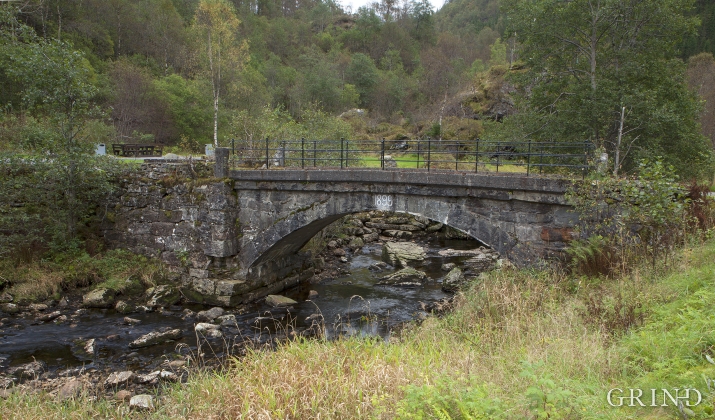Published: 05.08.2015 | Author: Statens vegvesen, Nils Georg Brekke, Ivar Bård Aadland
The bridge at Mørkhølen. (Svein Nord).
From times past there have been paths and transport routes across the mountains to the neighbouring settlements and to Bergen. One transport route went across Brekken to Samdal in Fana and continued on to Bergen. But the fastest road to town went across Gullfjellet, Lone and Borgeskaret.
From Tysse through Frølandsdalen and further across Kvamskogen to Hardanger there were also communication routes from older times. In 1860 the municipal council allocated money for bridges across the river at Mørkhølen and at Rossebotn below Storlid. Remains of the old road are still visible on the east side of the river between Frøland and Mørehølen and at Rossebotn. Mørkhøl bridge was built in 1898. It is about 21.5 metres long and its arch has a span of 9.4 metres. The roadway is 2.8 metres wide.
A drivable road from Tysse across Kvamskogen was completed to Norheimsund in 1906. The road also opened up for tourist traffic. In the 1920s the traffic with English and Dutch tourist ships on the Samnanger Fjord was especially great. The passengers were put ashore at Tysse and were transported by horses across Kvamskogen to Norheimsund where they were collected by boats.
Arched stone bridges
The first arched stone bridges in Norway were probably built around the end of the eighteenth century. These bridges represented an important technological advance in bridge construction. When building this type of bridge, wooden scaffolding was put up first. Hewn stones were then laid in place on the scaffolding. They were piled up from both sides - from the bottom up - towards the top of the arch. The actual roadway was constructed on top of this. Finally, the scaffolding was removed. The force of gravity presses the stones in the arch against each other and «locks» them into a span.




